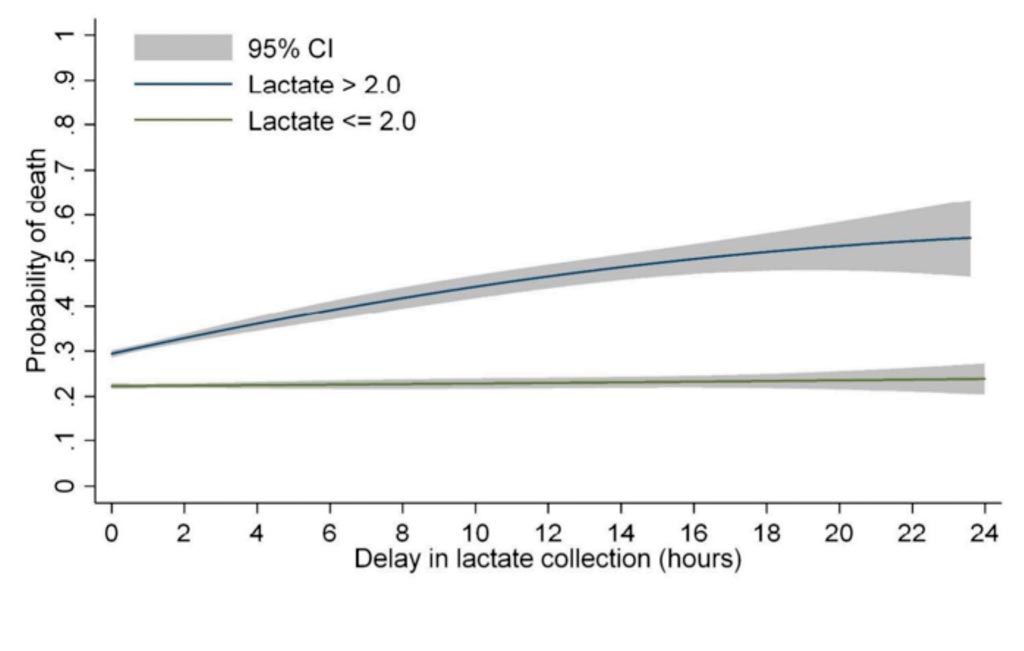Earlier Measurements Offer Quicker Treatment for Sepsis
By LabMedica International staff writers
Posted on 07 Jun 2018
Sepsis remains a significant cause of morbidity and mortality in the USA, leading to the implementation of the Severe Sepsis and Septic Shock Early Management Bundle (SEP-1). SEP-1 identifies patients with “severe sepsis” via clinical and laboratory criteria and mandates interventions, including lactate draws and antibiotics, within a specific time window.Posted on 07 Jun 2018
Because of a known association between elevated lactate levels and increased mortality, sepsis guidelines mandate that lactate levels should be tested soon after the onset of sepsis. A new study found that a significant proportion of patients with suspected sepsis do not have their lactates measured within the recommended timeframe.

Image: The relationship between delay in initial lactate measurement and the probability of in-hospital mortality for patients meeting SEP-1 criteria, stratified by level of initial lactate value (mmol/L) and adjusted for patient location, eCART score, and lactate value (Photo courtesy of University of Chicago).
Medical scientists at the University of Chicago (Chicago, IL, USA) reviewed the records of close to 150,000 patients admitted to a single tertiary care academic hospital from November 2008 to January 2016. Information regarding each patient's characteristics, vital signs, laboratory measurements, and medical therapy was analyzed. There was a particular focus on lactate measurements and levels.
The team identified 5,762 admissions that met the three SEP-1 criteria for severe sepsis within a six-hour period. Of these, only 60% had an initial lactate drawn within the SEP-1 specified timeframe. The team reported that 14% had their levels measured between three and 24 hours after the time of first suspicion of sepsis ("delayed lactates"), and more than one quarter had no lactate measurements at all. Whether lactates were measured promptly varied with where the patient was being treated; 79% of patients treated in the emergency department had levels measured within the specified time period compared with 55% in the intensive care unit (ICU) but only 32% in hospital wards.
Patients with delayed lactate measurements demonstrated the highest in-hospital mortality at 29%, with increased time to antibiotic administration (median time, 3.9 hours versus 2.0 hours). Patients with initial lactates greater than 2.0 mmol/L demonstrated an increase in the odds of death with hourly delay in lactate measurement (odds ratio = 1.02). The authors concluded that delays in lactate measurement are associated with delayed antibiotics and increased mortality in patients with initial intermediate or elevated lactate levels. Systematic early lactate measurement for all patients with sepsis will lead to a significant increase in lactate draws that may prompt more rapid physician intervention for patients with abnormal initial values.
Matthew M. Churpek, MD, MPH, PhD, an Assistant Professor of Medicine and lead investigator of the study, said, “Systematic early lactate measurements in patients presenting with sepsis would result in a significant increase in the number of lactates measured on patients but may be of benefit in identifying patients with elevated initial lactates who are at risk for poorer outcomes. Patients with early lactate measurements received earlier interventions such as antibiotic administration, which is known to improve mortality in sepsis.” The study was published on May 24, 2018, in the journal CHEST.
Related Links:
University of Chicago













